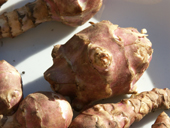
UK/Ireland
•Canada/USA
________________________________________________________________________

eat
sunchoke
Sunchoke (Jersualem
artichoke) look a bit like a knobbly pink-skinned ginger root and have
a sweet, nutty flavor, reminiscent of water chestnuts. Although
not widely used (perhaps because of its awkward appearance or anti-social
effects - see NUTRITION), they are an inexpensive and versatile food that
can be used both raw and cooked and make a delicious soup.
HISTORY
The sunchoke is native to North America. The French explorer Samuel de Champlain introduced them to Europe after coming across them at Cape Cod in 1605.
BIOLOGY
The sunchoke plant (Helianthus tuberosus) is related to the sunflower and produces edible tubers. It is hardy and grows readily in cold climates.
NUTRITION
Sunchokes are very rich in inulin, a carbohydrate linked with good intestinal health due to its prebiotic (bacteria promoting) properties. These health benefits come at a price; the food can have a potent wind-producing effect.
Sunchokes also contain vitamin C, phosphorus and potassium and are a very good source of iron.
TIPS
BUYING
Roots should be free from soft spots, wrinkles or sprouting. Knobbles
and uneveness are unavoidable (and not indicative of quality), but smoother,
rounder artichokes are easier to prepare.
STORING
Sunchokes will keep for a couple of weeks in the fridge.
PREPARING
Like potatoes, sunchoke can be served with or without the skin - scrub
clean and leave it on for maximum nutritional benefit.
Cook as you would potatoes - roast, sauté, bake, boil or steam. If peeling or cutting, drop pieces into water with a squeeze of lemon juice to prevent discoloration. Unlike potatoes, sunchokes can also be used raw (e.g. in salads) or lightly stir-fried.
OTHER STUFF
Sunchokes are used in the industrial production of fructose, which is derived from the inulin content of the vegetable.
PICK OF THE RECIPES
in
season:
january
february
march
april
may
june
july
august
september
october
november
december
main regions:
Central and Eastern USA and Canada
ONLINE
IN PRINT
-
Jerusalem Chicken
Wonderfoods -
Cheese and Onion Jerusalem Artichoke Gratin
The Complete Cookery Year
